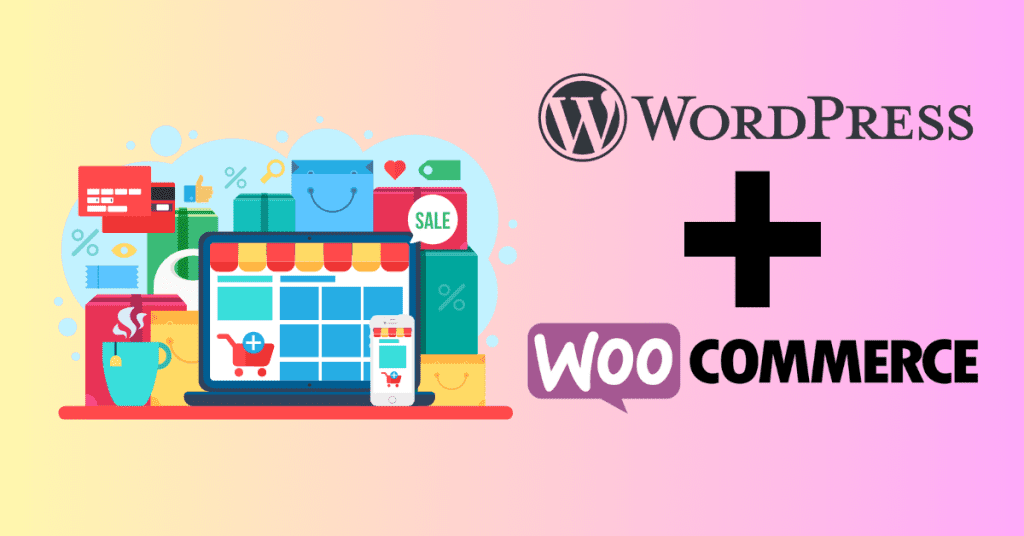Embarking on the journey to create your very own website is an exciting venture, and if you’ve chosen WordPress as your platform, you’re on the right track to a dynamic and customizable online presence. In this comprehensive guide, we’re about to unravel the step-by-step process of creating a WordPress website on Bluehost – a powerful hosting platform known for its reliability and user-friendly features.
Whether you’re a small business owner, an eCommerce enthusiast, a passionate blogger, or a seasoned webmaster, this guide is tailored to empower you with the knowledge and tools needed to bring your online vision to life. From registering a custom domain name to navigating the intricacies of the WordPress admin dashboard, we’ll walk you through each crucial step.
But it doesn’t stop there. With WordPress, you’re not just building a website. Instead, you’re sculpting a digital space that mirrors your unique identity. We’ll explore the vast landscape of WordPress themes, discuss the importance of choosing the right one, and guide you through customization options that will make your website truly yours.
Are you ready to dive into the world of WordPress with Bluehost as your trusty companion? Follow our guide, and let’s turn your aspirations into a fully functional and visually stunning website. Your online journey begins here – welcome to the realm of crafting a WordPress website on Bluehost!
Identify Website Goals
Before diving into the process of creating a website, it’s essential to identify and define your website goals. This initial step lays the foundation for a purposeful and effective online presence.
Begin by considering the primary objective of creating your website. Are you looking to sell products, provide information, or generate leads? Each goal requires a tailored approach in terms of design, functionality, and content.
For instance, an e-commerce site would prioritize seamless navigation, secure payment gateways, and an appealing product showcase, while an informational site might emphasize engaging content, easy accessibility, and a user-friendly layout.
Once you’ve pinpointed the overarching goal, break it down into specific, measurable, achievable, relevant, and time-bound (SMART) objectives. These could include increasing website traffic, boosting online sales by a certain percentage, or enhancing user engagement. Understanding these specific goals enables you to develop a targeted strategy for content creation, design, and user experience.
Regularly revisiting and reassessing these objectives throughout the website development process ensures that your site remains aligned with your evolving business goals and continues to serve its intended purpose effectively. In essence, by identifying website goals upfront, you set the stage for a purpose-driven and successful online presence.
Why Use WordPress for Website Creation
If you want to create a website, we will always suggest going for WordPress. The same platform that powers this blog.
User-Friendly Interface
WordPress stands out as a premier choice for website creation due to its user-friendly interface. This makes it accessible for both novices and experienced developers. The platform’s intuitive dashboard simplifies navigation and tasks, facilitating efficient website management. Its flexibility and customization options are notable, offering an extensive selection of themes and plugins to tailor the website’s appearance and functionality according to individual needs.
Open Source Platform
Being an open-source platform, WordPress is not only cost-effective but also encourages community collaboration, resulting in continuous improvements and updates. The SEO-friendly nature of WordPress is a significant advantage, providing built-in features to enhance a website’s visibility on search engines. Additionally, many WordPress themes are responsive, ensuring a consistent user experience across various devices.
WordPress Community Support
The active and supportive community surrounding WordPress contributes to its appeal. Users can tap into forums, tutorials, and documentation for assistance and stay informed about the latest trends and best practices. Security is a priority, with regular updates addressing vulnerabilities and the availability of plugins to fortify website defences.
Website Scalability
WordPress is scalable, accommodating websites of various sizes and purposes. Whether starting with a simple blog or expanding to a complex e-commerce site, the platform handles growth seamlessly. Efficient content management is another strength, with a straightforward editor and tools for scheduling posts, managing categories, and optimizing content.
Furthermore, WordPress facilitates integration with third-party services, enabling users to seamlessly connect their websites with social media, email marketing tools, analytics, and more.
Choose A Domain and Hosting Provider
Differing from other all-in-one website builder solutions like Wix and Shopify, WordPress will require you to get your domain and web hosting ready.
If you don’t know which to choose, you may try Bluehost. One of the web hosting providers recommended by WordPress officials. Bluehost offers seamless integration with WordPress. With Bluehost, you can easily register a domain name and install WordPress with a single click.
Start Your Website Today with Bluehost!
Choosing a domain and hosting provider is a crucial step in establishing your online presence. Here’s a guide to help you make informed decisions:
1. Define Your Needs:
Understanding the purpose of your website is paramount when choosing a domain and hosting provider. Whether it’s a blog, e-commerce site, portfolio, or another type, your needs will dictate the features required. Additionally, estimating the expected traffic is crucial, as some providers may be better suited for smaller websites while others can handle higher traffic volumes more efficiently.
2. Domain Name
Selecting the right domain name is essential for your online identity. You should opt for a name that reflects your brand and is easy to remember. This will include relevant keywords in the domain that can improve search engine optimization. When choosing a domain extension, consider the purpose of your website and the availability of your desired name. In addition, you may also use domain search tools provided by reputable registrars like Namecheap to ensure your chosen domain is available.

This is a very important step in establishing your online presence. Your domain name is more than just an address. Instead, it’s the representation of your online identity, often referred to as a URL. For instance, bennietay.com serves as the domain name for this website.
When choosing potential domain names, you may consider keywords, phrases, or slogans that set your brand apart from the competition. In fact, you should opt for a name that is short, catchy, and easily memorable. This will help in user engagement as they navigate to your site. A prime example of this approach is evident in successful brands like Google, Facebook, Twitter, and Apple, which not only excel in their industries but also boast unique, recognizable, and easily pronounceable domain names.
To aid in your quest for the perfect domain, leverage the benefits of a domain name generator. This tool ensures your desired domain name is not already in use and provides creative alternatives. Additionally, it may suggest different top-level domains (TLDs), the extensions that follow the “dot” in a web address. While standard TLDs include .com, .org, or .net, exploring innovative options such as .me, .io, .xyz, .bio, and .blog can add a distinctive touch to your online identity.
3. Hosting Provider
Once you’ve settled on the ideal domain, then the next step is to find the perfect website hosting plan. The abundance of hosting options may seem overwhelming, but reputable providers like Bluehost offer a diverse range of plans tailored to accommodate websites of varying sizes.
Consider these hosting plans as the virtual “homes” for your site, where you essentially rent space based on your specific needs. Regardless of the hosting plan, essential features such as site security, maintenance, and services to facilitate website creation are included.
When selecting a WordPress hosting plan, several factors demand attention. First, determine the number of websites you intend to create. Assess the types of files and creative elements you’ll incorporate into your website, as this influences the required storage capacity. Additionally, consider whether you need a high level of customization, security, and reliability.
For most business owners, shared web hosting proves to be the optimal choice. This option is cost-efficient as it involves sharing the hosting space with multiple customers, and the hosting company manages security and maintenance updates. However, dedicated and VPS hosting alternatives exist, providing more control over designated space. Ultimately, choosing these hosting packages depends on your specific needs and preferences.

Determine the type of hosting that suits your needs, such as shared, VPS, dedicated, or cloud hosting. Shared hosting is cost-effective for beginners, while larger websites may benefit from VPS or dedicated hosting. Assess the hosting provider’s performance, including server speed and uptime guarantees. Scalability is crucial, ensuring that the hosting plan can accommodate your website’s growth.
Start Your Website Today with Bluehost!
4. Technical Features
Consider the technical aspects of the hosting service. A user-friendly control panel, such as cPanel or Plesk, simplifies website management. Access to reliable customer support is essential, preferably with 24/7 availability through various channels. Prioritize security features, such as SSL certificates and regular backups, to protect your website from potential threats.
5. Reviews and Recommendations
Before making a decision, research customer reviews and testimonials. Gain insights into the experiences of other users with the hosting provider. Additionally, seek recommendations from friends, colleagues, or online communities to gather firsthand information about the strengths and weaknesses of different providers.
Installing WordPress with Bluehost
Bluehost offers a seamless and user-friendly experience when it comes to installing WordPress on your hosting account. Upon selecting your package plan and completing the sign-up, you will be directed to the one-click installation page for WordPress.

This one-click installation saves you lots of time and effort to install WordPress without any technical experience. As the official web hosting provider for WordPress, Bluehost’s integrated approach ensures a smooth transition, allowing you to jump right into the website-building process without any hindrances.
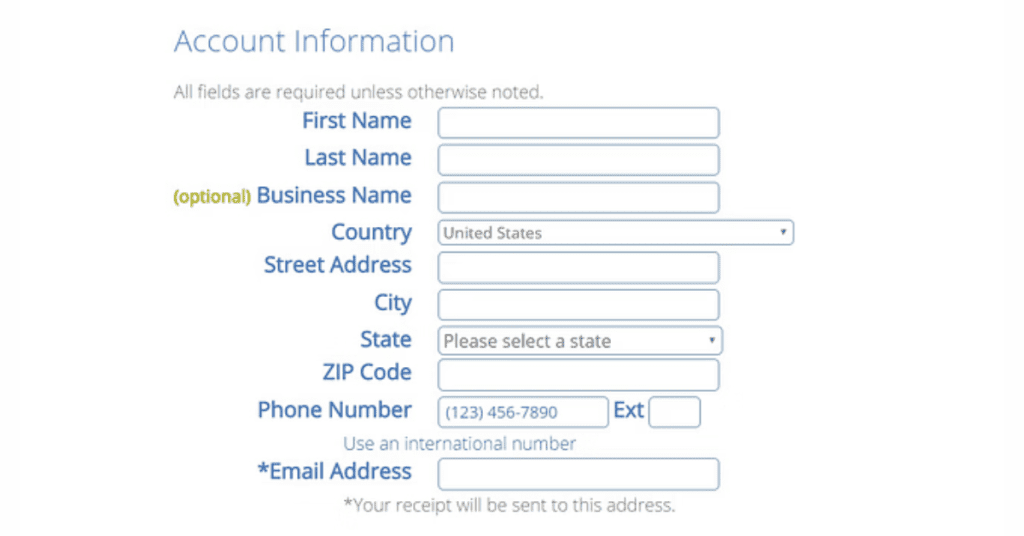
Once the installation is complete, accessing your WordPress website is a breeze. Simply log in to the WordPress admin dashboard using your credentials, and you’ll encounter a user-friendly interface. This dashboard becomes your control centre, empowering you to manage every aspect of your website, from customizing the design to crafting engaging content. With Bluehost and WordPress, you gain a powerful foundation that puts you in control. This will enable you to shape your online presence with confidence and ease.
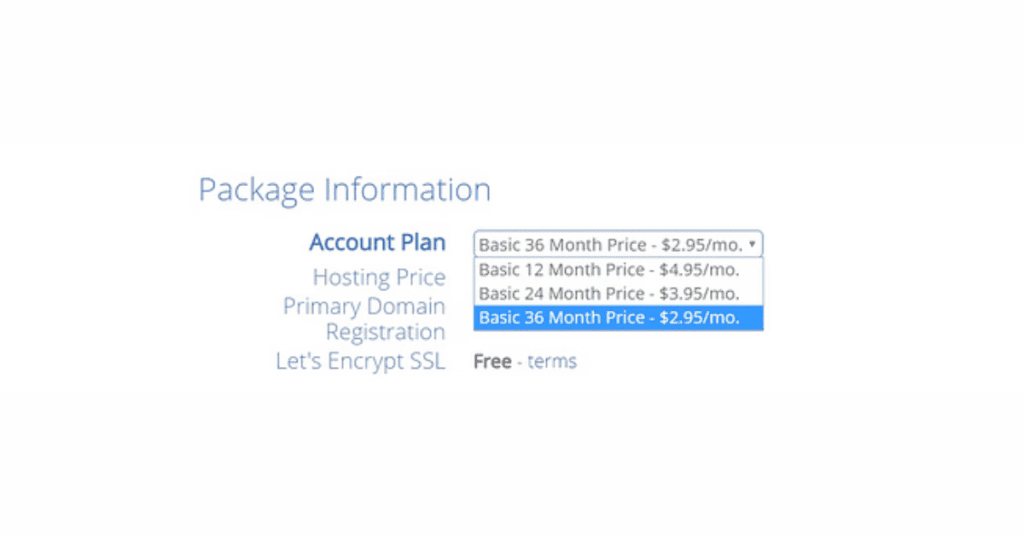
In essence, the combination of Bluehost and WordPress provides the perfect foundation for your website creation journey. Dive in and unlock the full potential of your online venture with the assurance that you have a reliable and user-friendly platform at your fingertips.
Accessing the WordPress Website Admin Page
Upon logging into your Bluehost account manager, the initial view will present your homepage. To navigate to your hosting details and the list of sites you currently own, click on “Hosting.” This action directs you to a comprehensive overview of your hosting plan and associated websites.

For direct access to your website, locate and click on the three dots positioned to the right of your site. This option allows you to log in seamlessly to your website, providing immediate entry to your WordPress admin dashboard. Streamlining the process, this feature ensures efficient and straightforward management of your website within the Bluehost platform.
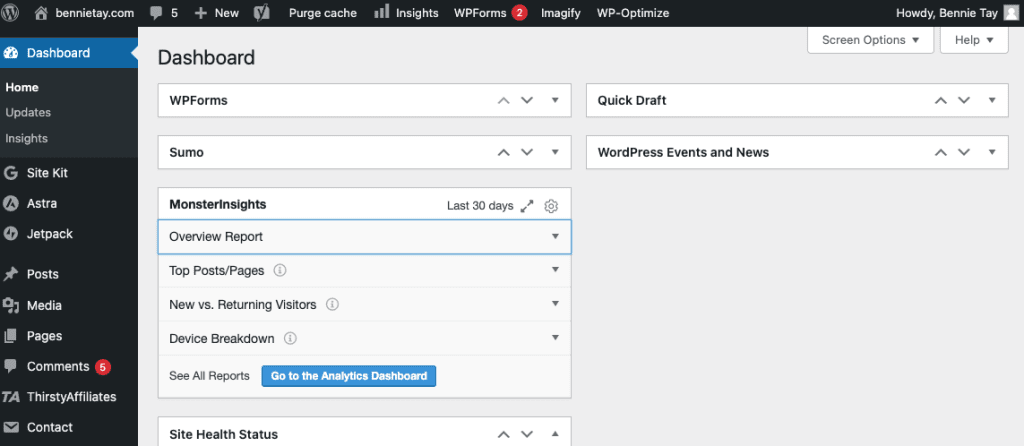
Alternatively, you can access your WordPress admin page from https://www.yourdomainname.com/wp-admin. Then, log in using your credentials to access your admin page.
Choosing A WordPress Website Design and Theme
If you are not a designer, you might not know how to start. Fortunately, WordPress offers hundreds of customizable themes to choose from. Starting with a pre-built and customised based on your website requirement is easier than starting from scratch.
A well-suited theme has the power to captivate visitors, convey your brand’s personality, and enhance the overall user experience. Hence, you should invest time in finding a theme that aligns with your website’s purpose and resonates with your target audience.

When exploring themes for WordPress, two primary options exist: the official WordPress theme directory and premium theme marketplaces. The WordPress theme directory boasts a vast collection of free themes that can be easily browsed and installed directly from your WordPress admin dashboard. Conversely, premium theme marketplaces like ThemeForest provide professionally designed, feature-rich themes for a fee.
During your theme evaluation, consider crucial factors such as design aesthetics, responsiveness, customization options, and user reviews. You should opt for a visually appealing design that mirrors your brand’s identity and creates a positive impression. In addition, ensure the theme is responsive, adapting seamlessly to various devices and screen sizes for an optimal user experience.
Besides, customization options are essential. It will allow you to tailor the theme to your specific needs without requiring coding expertise. Additionally, factor in user reviews and ratings to assess the theme’s reliability, performance, and the level of support provided by the theme developer.
Selecting the right theme is an investment in your website’s success. Take the time to explore diverse options, compare their features, and envision how they align with your brand. By choosing a theme that resonates with your audience and supports your goals, you’ll be well on your way to creating a visually stunning and engaging website that leaves a lasting impression.
How to Install a WordPress Website Theme
Now let’s navigate to your WordPress admin page.
Firstly, on your admin page, navigate to the left menu and hover over “Appearance.” This action will reveal another menu with three options.
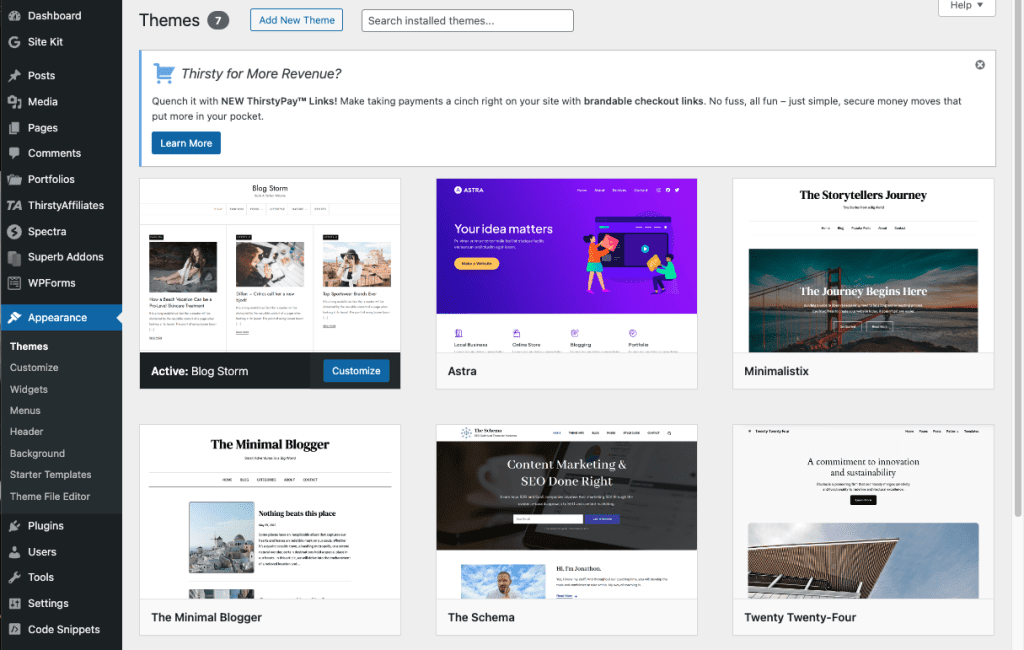
Then, choose “Themes,” which will lead you to an overview of the themes already installed on your WordPress site.
To add a new theme, you have two options. Either click on the large square with a plus sign at the centre of the page or select “Add New,” positioned between the title and the search bar at the top.
This will take you to an overview of all the available themes. You can scroll through the options until you find one that suits your preferences. Then, hovering your cursor over a theme provides two choices: “Preview” to see how the theme looks or “Install” to immediately add it to your website.

Once you’ve clicked “Install,” the theme will be installed and visible in your Themes overview. However, it’s not actively applied to your site yet. To do this, click on “Activate” after you’ve successfully installed the theme. This final step ensures that your chosen theme is now in use on your website.
Customize Your WordPress Website
The WordPress Customizer serves as your portal to personalize your website. You can access to the Customizer from the Appearance -> Customize button on the left navigation bar. Through the Customizer, you wield the ability to customize various aspects of your site, transforming it into a unique representation of your brand.
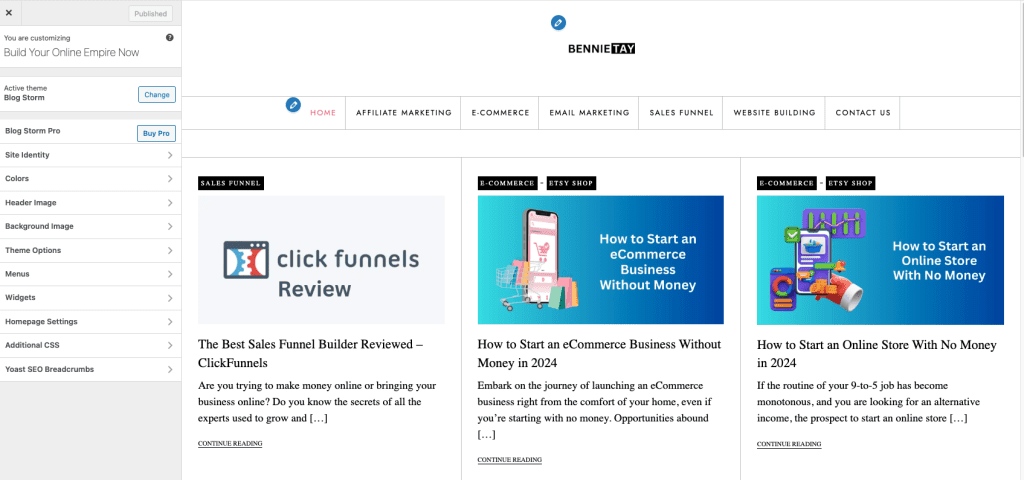
Firstly, begin the customization journey by adjusting the site’s title, tagline, and logo. These are crucial elements for brand recognition and defining your website’s identity. You need to opt for a compelling site title and tagline that authentically conveys your brand’s essence. Then, incorporate a professional logo to reinforce your visual identity and enhance your site’s recognizability.
The Customizer extends its capabilities to the layout, colours, fonts, and background of your website pages. Firstly, you need to select a layout that complements your content structure and enhances user experience. Besides, you can experiment with colour schemes aligned with your brand’s aesthetics, aiming to evoke specific emotions. In addition, choose fonts that are not only easy to read but also reflective of your brand’s personality. Lastly, set a background that harmonizes with your overall design, adding visual interest to your site.
Besides, you can enhance your website’s functionality by incorporating plugins, menus, and social media integration. Plugins allow the addition of useful elements like a search bar, recent posts, or a contact form to your sidebar or footer. You need to craft menus to streamline navigation. This will make it easy for your visitors to explore your site seamlessly. Finally, integrate social media buttons to encourage sharing and expand your online presence.
The WordPress Customizer empowers you with endless possibilities for website customization. Harness this powerful tool to craft a visually appealing, user-friendly, and engaging online presence that authentically represents your brand.
Creating and Managing Website Content
In WordPress, distinguishing between posts and pages is crucial for effective content management. Posts are typically employed for blog-like content, where articles, news, or updates are published in chronological order. These posts are displayed in reverse chronological order on your website’s blog page and can be categorized and tagged.
On the contrary, pages are more static and are utilized for unchanging content such as About Us, Contact, or Services pages. They are not organized by date and provide timeless information.
Firstly, crafting and formatting engaging content in WordPress is made simple with its user-friendly editor. The editor, resembling a word processor, offers a familiar interface for composing content, adding headings, formatting text, and creating lists. You can leverage this tool to create compelling articles that capture your audience’s attention. You need to also ensure readability by keeping paragraphs concise, incorporating bullet points, and utilizing subheadings.
Besides, you need to include images, videos, and other media elements in your blog. Visuals play a pivotal role in engaging readers and conveying information effectively. You can insert relevant images and optimize them for web use to ensure swift loading times. Besides, embed videos from platforms like YouTube or Vimeo to introduce dynamic content. Additionally, consider using infographics, charts, or diagrams to visually present data or complex information.
In addition, to ease your visitor’s experience, you should organize your content effectively using categories and tags. Categories aid in structuring content and establishing a logical hierarchy. You can select broad topics that encompass your content and assign appropriate categories to each post. Tags, on the other hand, provide more specific descriptors, enabling visitors to easily discover related articles and enhancing overall website navigation.
Extending WordPress Website Functionality with Plugins
WordPress plugins serve as powerful tools that significantly enhance the functionality of your website. Comparable to add-ons, these plugins can be installed to add specific features or introduce entirely new capabilities to your WordPress site. With a wide range of options, plugins offer limitless possibilities. This will enable you to customize and optimize your website according to your unique requirements.
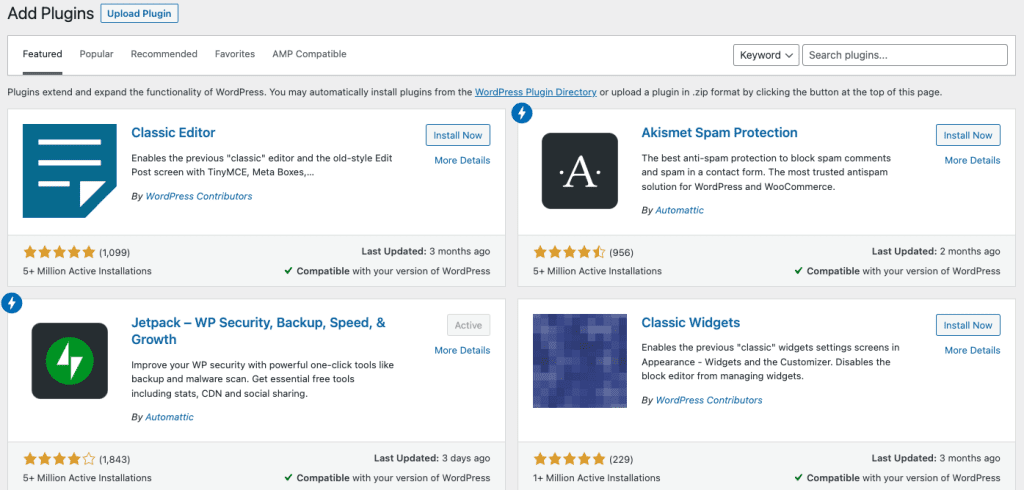
When considering essential plugins, there are several categories that every website owner should explore. Firstly, security plugins play a crucial role in safeguarding your site from potential threats and vulnerabilities. These plugins provide features such as firewall protection, malware scanning, and login security, contributing to the overall security of your website.
For optimizing your site’s visibility in search engine results, SEO plugins are essential. An example is the Yoast SEO plugin, which facilitates keyword optimization, sitemap generation, and effective management of meta tags.
Performance optimization plugins are invaluable for improving your site’s speed and reducing load times, ensuring a seamless user experience. These plugins can cache your content, minify CSS and JavaScript files, and optimize images to enhance overall site performance.
To facilitate social media engagement, social sharing plugins are beneficial. These plugins make it easy for visitors to share your content on various social media platforms, expanding the reach and engagement of your website’s traffic.
By strategically incorporating these essential plugins into your WordPress site, you can fortify its security, enhance search engine visibility, optimize performance, and boost social media engagement. These tools contribute to a well-rounded and efficient website that meets the needs of both visitors and site administrators.
How to Install a WordPress Website Plugin
Let’s start by heading to the homepage of your WordPress admin.
On the left-hand side, you’ll find the “Plugins” option. Hover over it to reveal a small menu with three choices. Select “Add New.”
This action will display an overview of all the plugins available for download. Utilize the tabs labelled Featured, Popular, and Recommended to explore the variety of plugins WordPress has to offer.

To install a plugin, simply click on “Install Now.” Once the installation is complete, the button will change to “Activate.” Click on “Activate” to enable your newly installed plugin on your site.
Many plugins come with configuration settings that can be accessed either from the “Plugins” or “Settings” menu. These settings allow you to customize the behaviour of the plugin according to your preferences.
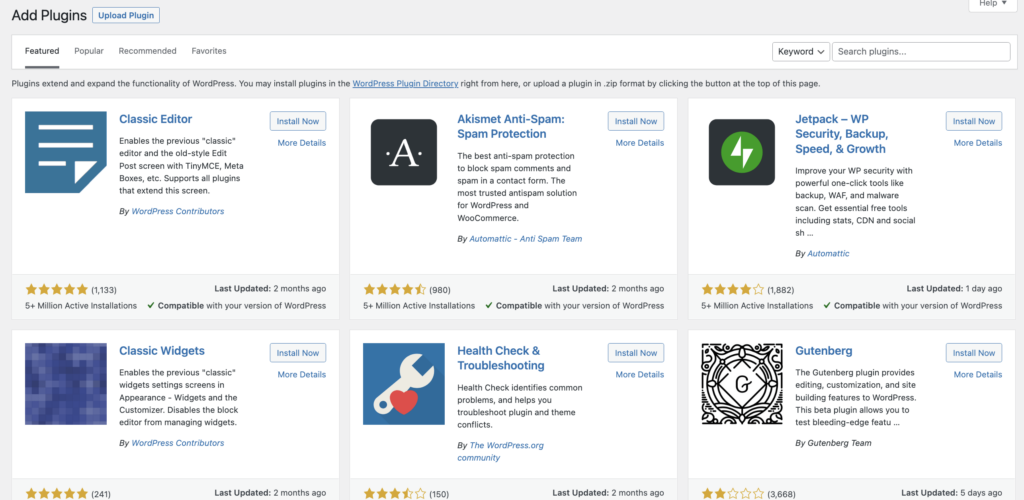
Make the most of the extensive range of plugins available to enhance your website’s security, improve SEO, optimize performance, and encourage social sharing. Carefully choose and configure plugins that align with your specific goals, and ensure that they are regularly updated to guarantee compatibility and security. With the right combination of plugins, you can extend the functionality of your WordPress site, propelling it to new heights of success.
Creating Your WordPress Website Content
Crafting a user-friendly website is paramount for attracting and retaining visitors. A positive user experience not only encourages prolonged engagement and content interaction but also increases the likelihood of conversions and loyal readership. To ensure the success of your website, you need to prioritize a seamless user experience.
Responsive design and mobile optimization stand as foundational elements for a user-friendly website. Given the prevalent use of mobile devices, your site must look and functions well across various screen sizes. Responsive design enables your website to automatically adapt its layout, providing an optimal viewing experience on smartphones, tablets, and desktop computers. Mobile optimization, on the other hand, involves refining loading speed, minimizing large images, and ensuring intuitive navigation on mobile devices.
Besides, improving site speed and performance is equally critical for enhancing user experience. Slow-loading websites can lead to user frustration and higher bounce rates. You can utilize caching plugins to store static versions of your site, promoting faster loading times. When uploading an image, optimize it by compressing it without compromising quality. Minify CSS and JavaScript files to reduce their size and enhance loading speed. Regularly updating plugins and themes ensures compatibility and security.
In addition, implementing techniques like lazy loading, which loads images and content only when the user scrolls to them, further contributes to improved web page speed. Additionally, leverage content delivery networks (CDNs) to distribute your site’s files across multiple servers, minimizing the distance between the user and your website’s data.
Finally, prioritizing user experience through responsive design, mobile optimization, and site speed improvements creates a welcoming and engaging environment for your visitors. A user-friendly website not only boosts engagement and conversions but also fosters a positive brand image and establishes enduring relationships with your audience.
How to Create a New Page for Your Website
Let’s start at the homepage of your WordPress admin.
Firstly, hover over “Pages” in the left menu, which will prompt another menu to appear with two options.
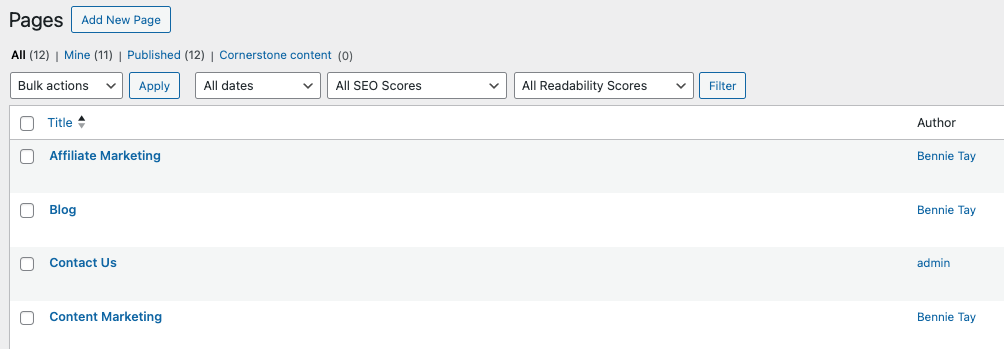
Then, select “Add New.”
This action will lead you to a new, blank page where you can commence adding your content. Best of luck with creating your page! If you have any further questions or need assistance along the way, feel free to ask.
Add New Blog To Your Website
Blogs have become quite prevalent in today’s digital landscape, offering an accessible platform for sharing ideas, building a brand, and driving traffic to your website. Blog posts serve as an ideal space for enhancing your SEO strategy by targeting specific keywords to improve search engine rankings. Additionally, a well-maintained blog can establish your brand as an authoritative voice on particular topics.
It’s important to ensure that your blog content resonates with your audience’s interests. While creating an aesthetically pleasing space with engaging words and images is essential, the key lies in providing useful and relevant content that meets the needs of your visitors. Simply put, the effectiveness of a blog goes beyond its visual appeal – it hinges on delivering meaningful and valuable information that captivates and benefits your audience.
How to Add New Blog Posts to Your Website
To add a new blog post, navigate to the WordPress admin menu on the left, and hover over “Posts,” revealing an additional menu featuring four options.
Then, opt for “Add New.” This action will direct you to a blank post, providing you with the canvas to commence writing your inaugural blog post. It’s as straightforward as that!

Activate eCommerce Feature using WooCommerce
Setting up an online store using WordPress is made easy with plugins like WooCommerce. WooCommerce is a robust and widely-used eCommerce solution that integrates with WordPress seamlessly. Besides, it’s equipped with the essential tools for creating and managing your digital storefront.
Firstly, you need to install and activate the WooCommerce plugin from the WordPress plugin directory. Once activated, WooCommerce will assist you through the initial setup. This includes the configuration of crucial settings like currency, shipping preferences, and tax regulations.
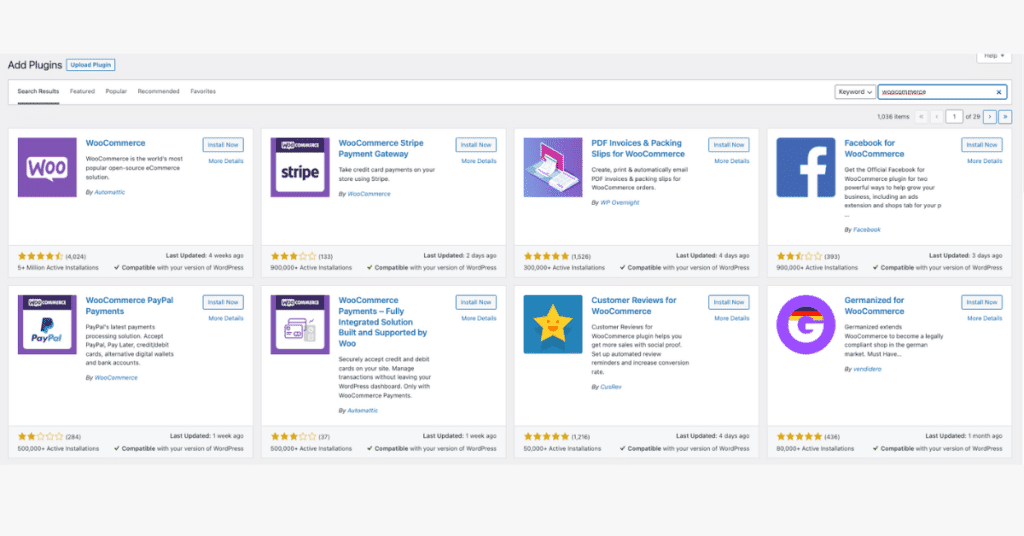
Adding new products to your online store is easy with WooCommerce. On the WooCommerce dashboard, you can create product listings and incorporate details such as title, description, pricing, and images effortlessly. Besides, you will have the flexibility to categorize your products and attribute characteristics like size, colour, or material. In addition, WooCommerce provides extensive customization options, allowing you to present your products in the most appealing manner.
The configuration of payment gateways is important to ensure secure and convenient transactions. WooCommerce supports a variety of popular payment gateways, including PayPal, Stripe, and Authorize.net. To set up the payment gateway, you need to select the payment gateways that align with your business requirements and follow the provided instructions for setup. This facilitates customers to make purchases using their preferred payment methods.
Effective order management is foundational to operating an online store. WooCommerce offers a comprehensive system for this purpose. Through the WooCommerce dashboard, you can effortlessly track and process orders, generate invoices, and update order statuses. Additionally, you can manage inventory, establish automated email notifications to keep customers informed and handle refunds or returns.
By leveraging the combined capabilities of WooCommerce and WordPress, you gain access to a resilient and adaptable platform for building and expanding your online store.
WordPress Website Security
Website security is the most important for your website to protect both your business and your users’ data. A secured website not only builds trust but also safeguards sensitive information from unauthorized access or malicious attacks. Website security should be the top priority for your website.
Initiating fundamental security measures is the primary step in reinforcing your website’s defences. Firstly, you need to employ strong, unique passwords for all user accounts and regularly update them. Besides, you can enhance security by enabling two-factor authentication as an additional layer of protection.
In addition, regularly backing up your website’s files and databases can ensure swift restoration in the event of a security breach or data loss. You need to keep the WordPress core, themes, and plugins up to date to address security vulnerabilities and benefit from the latest security enhancements.
Security plugins can provide an extra layer of protection for your WordPress website. Renowned security plugins like Wordfence or Sucuri offer features such as malware scanning, firewall protection, and login security measures.
You can configure these plugins to monitor suspicious activities, changes to files, and receive notifications regarding potential security threats. Besides, by implementing best practices like limiting login attempts, blocking IP addresses exhibiting suspicious activities, and securing your website’s login page you can avoid those security issues.
It’s important to follow security best practices involving using secure hosting, implementing SSL certificates to encrypt data transmission, and securing your website’s database. Regularly monitoring your website for signs of security breaches or unauthorized access is crucial. Keep yourself and your team informed about common security threats and stay abreast of emerging vulnerabilities to proactively address them.
Launch and Promote Your WordPress Website
Before the launch of your WordPress website, you need to conduct a final review to ensure everything is in optimal order. You must proofread your content, checking for spelling and grammatical errors thoroughly. Take some time to review all pages, posts, and media files, verifying correct formatting and visual appeal. A professional website will increase your credibility.
Besides, you need to make sure there are no broken links and confirm the proper functioning of both internal and external links. This attention to detail guarantees a seamless and professional user experience.
Once your website is ready for launch, it’s time to promote it and drive traffic to it. You can leverage social media platforms to share your website and actively engage with your target audience. You can do this by crafting compelling and shareable content that not only sparks interaction but also entices readers to explore your site.
Besides, you should also implement search engine optimization (SEO) techniques to enhance your website’s visibility in search engine results. This is done by emphasizing relevant keywords, meta tags, and high-quality content aligned with your target audience’s interests.
In addition, you can explore online marketing strategies like email marketing, paid advertising, and collaborations with influencers or pertinent websites in your niche. Building an online presence is a gradual process, so maintain patience and consistency in your promotional endeavours.
While the launch marks an exciting milestone, it signifies just the beginning. Concentrate on promoting your website across diverse channels, actively engaging with your audience, and continuously refining your content and user experience. Through the strategic use of social media, the implementation of SEO strategies, and the proactive solicitation of feedback, you can attract visitors, cultivate a loyal following, and realize your online goals.
Final Thoughts: How to Create a WordPress Website on Bluehost
We’ve shared everything you need to know about how to establish a website with WordPress to cater for the needs of small business owners, eCommerce store operators, bloggers, and webmasters. It underscores the significance of having a website and emphasizes the advantages of employing WordPress as a versatile content management system.
The initial steps, including registering a custom domain name, subscribing to web hosting via Bluehost, and accessing the WordPress admin dashboard, were thoroughly covered.
With WordPress, you gain access to a user-friendly interface and extensive customization options, empowering you to craft a website that mirrors your distinct vision. We’ve also discussed the importance of getting the right theme and how to customize it so it fits your branding. Additionally, it touches upon aspects such as crafting and managing content and enhancing functionality through plugins.
The potential for building a WordPress website is limitless and armed with the provided resources and guidance, you are well-prepared to embark on this thrilling journey. The encouragement is to take decisive action today and commence the process of constructing your website. Every step taken brings you closer to your goals. Embrace the enthusiasm and anticipate the potential for success that accompanies the creation of a WordPress website, relishing the journey of bringing your online presence to fruition.




